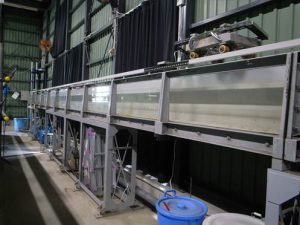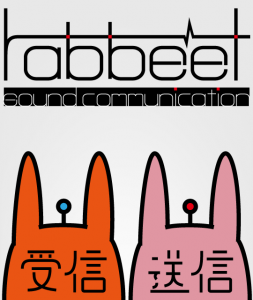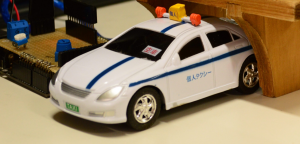Profile
Tadashi Ebihara is an Associate Professor at the Faculty of Engineering, Information and Systems, University of Tsukuba, Japan.
He received the B. Eng., M. Eng. and Ph.D.(in Eng.) degrees from University of Tsukuba, Tsukuba, Japan. His doctoral degree thesis was about a design of acoustic communication system.
He conducts research mainly in digital communications and signal processing. He is interested in design of communication system and performance analysis, especially underwater acoustic communication. Shallow water acoustic channel is interesting because the effects of inter-symbol interference and Doppler spread can become several orders of magnitude greater than those observed in a communication system using radio. He is also interested to communication system for consumer electronics.
He is an active member of the IEEE, the Acoustical Society of America, the Marine Acoustical Society of Japan, the Acoustical Society of Japan,the Institute of Electronics, Information and Communication Engineers, and the Societies of Agricultural Structures, Japan.
Carrier
Apr. 2016 —
Associate Professor, Faculty of Engineering, Information and Systems, University of Tsukuba
Apr. 2010 — Mar. 2016
Assistant Professor, Faculty of Engineering, Information and Systems, University of Tsukuba
Sep. 2013 — Dec. 2013
Visiting Professor, Circuits and Systems Group (link), Delft University of Technology, The Netherlands. Collaborating with Prof. Geert Leus.
Research
Underwater acoustic communication system (2010-)
Underwater acoustic (UWA) communications in shallow water play an important role for various activities, such as navigation and communication for underwater autonomous vehicles, and a demand for high-speed communication is now increasing. However, high-speed UWA communication in shallow water is still an ongoing challenge due to the characteristics of the UWA channel. In detail, UWA channel in shallow water is characterized by severe multipath propagation, time-variations of the channel, and limited bandwidth. Moreover, the physical space and the battery power of the communication platform are usually limited. Under these constraints of the UWA channel and communication platform, high-speed, reliable, and power efficient communication links are required.
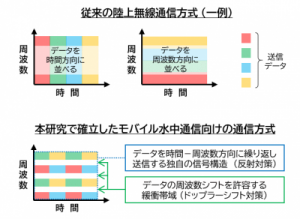 At present, I work on specific signal processing methods to achieve above requirements, such as orthogonal signal division multiplexing (OSDM), orthogonal frequency division multiplexing (OFDM), and single-carrier modulation with adaptive equalizer. I am also interested in network protocols because UWA network will play an important role for resource exploration and coastal security.
At present, I work on specific signal processing methods to achieve above requirements, such as orthogonal signal division multiplexing (OSDM), orthogonal frequency division multiplexing (OFDM), and single-carrier modulation with adaptive equalizer. I am also interested in network protocols because UWA network will play an important role for resource exploration and coastal security.
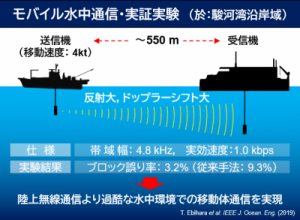 To evaluate the performance of UWA communication methods, conducting an experiment is necessary. Thanks to the cooperation of the member of the Center for Research in Isotopes and Environmental Dynamics, University of Tsukuba, I conduct basic tests in a test tank with wave-making device. Furthermore, I conduct advanced tests in a coastal area of the Suruga Bay, Japan.
To evaluate the performance of UWA communication methods, conducting an experiment is necessary. Thanks to the cooperation of the member of the Center for Research in Isotopes and Environmental Dynamics, University of Tsukuba, I conduct basic tests in a test tank with wave-making device. Furthermore, I conduct advanced tests in a coastal area of the Suruga Bay, Japan.
This work has been supported by the Japan Society for Promotion of Science (FY2010-2011, FY2012-2013, FY2015-2018, and FY2019-2022), and the Murata Science Foundation Overseas Dispatch Program.
Acoustic communication system for mobile devices (2011-)
Recently, acoustic communication targeted for mobile devices has been attracted many researchers as the computational capacity of the mobile device increases. The acoustic communication requires only a pair of microphone and loudspeaker, which a variety of mobile devices employ.
Although the modem could be installed as software, numerous calculations are required to the mobile devices to achieve acoustic communications, whose computational power is improving but still lacked to perform the acoustic communication.
At present, I work on a software-based implementation of the modem whose calculation cost is small and suitable for mobile devices.
Visible light communication system for intelligent transport systems (ITS) (2014-)
Visible light communication is one of the critical technologies for intelligent transport systems (ITS). The visible light communication can utilize current LED lighting equipment as a transmitter, and it has an advantage that we can develop large-scale communication system by utilizing existing infrastructure (e.g. tail ramp of the vehicle and traffic signal) as a transmitter. However, current visible light communication system requires complicated and expensive devices for the receiver, such as high-frame-rate image sensor.
To provide high-speed visible light communication with existing simple devices, such as smartphone, I work on design of optical attachment for smartphone.
This work has been supported by the Japan Society for Promotion of Science (FY2018-2020).
Teaching
Undergraduate (College of Engineering Systems)
- Communication Engineering (2015-)
- OS and Network (2014-2018)
- Measurement Engineering (2012-2014)
- Engineering Systems for Human Life (2012-2018)
- Introduction to Engineering Systems I (2010, 2011)
- Applied Laboratory of Intelligent Interactive Systems (2010-)
- Applied Laboratory of Intelligent System Technologies (2010-)
Graduate (Department of Intelligent Interaction Technologies)
- Fundamentals of Intelligent Interactive Technologies (2013-)
- Seminar in Intelligent Interaction Technologies V (2010-)
- Seminar in Intelligent Interaction Technologies VI (2010-)
- Digital Communication (2011-)
Graduate (Ph.D. Program in Empowerment Informatics)
- Smart Human Sensing (2015-)


